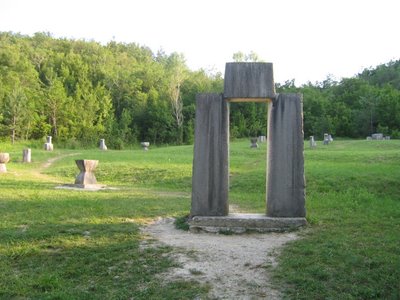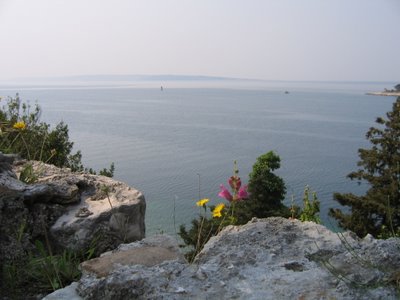Back Home
I've been back in the State now for over two weeks. The journey back was long and arduous, but much better than it could have been (I guess one can almost always say that). As I was leaving things were really heating up in the war between Israel and Lebanon. A lot of people were trying to leave there, so I was very conscious of how much more difficult my travel could have been.
I left Rijeka on Sunday morning, 16 July. Getting my two heavy suitcases and my heavy knapsack (with computer inside) from my apartment down several flights of stairs to the street was the first challenge. I took it bit by bit and bag by bag. Once on the street I realized that I was only 50 meters from the bus stop, so rather than wait for the taxi that might not come (in a half hour), I dragged everything down to the bus stop. This was easy since the bags both roll. Getting everything onto the bus was more of a challenge, and then getting it all off the bus was another challenge, but I did it. I took the big Greyhound type bus (Autotrans as it's known in Croatia) to Zagreb. It's about a two and a half to three hour ride and costs about $22. Once in Zagreb I took a taxi to my hotel, the only hotel near the airport. I received the embassy rate there, but it was still $130, the most I paid for a night's stay anywhere in Croatia. Since my flight was early Monday morning, it made sense to get there the day before and be in Zagreb to ensure getting to the airport on time. The hotel was fairly generic and in an industrial area with no restaurants or anything around it. I was supposed to go into the city to meet a friend that evening. But I was so tired and feeling out of sorts (I guess because of leaving), that I couldn't drag myself into town. I ended up sleeping for several hours and then just eating food I had with me instead of a proper dinner.
The next morning I was up at 5:00 am and left the hotel at 5:45 to get to the airport (by taxi). I had been warned that the Zagreb airport can have really long lines in the summer tourist months. And during previous days I had been seeing reports on Croatian television of long, long lines of cars backed up on the highways in Croatia because of the influx of tourists. They also showed long lines of tourists at the airport. But I must have gotten there just early enough, so in fact I got through the check-in process quite quickly and smoothly. My flight (Croatian Air) to Paris was delayed for some reason, but not for too long. So we got into Paris a half hour late. Luckily I had a three and a half hour layover. Charles de Gaulle airport was undergoing construction or remodeling or something, so I had to take two busses and walk quite a distance to get to my gate. It took almost two hours just to do the transit from my arriving flight to the departing one. But I made it on time and even had an hour before boarding the second leg of my flight. On the flight into Paris I had good views of the town and picked out the Eiffel Tower.
On the long flight between Paris and Detroit, I had a very good exit row (first row) seat, near the galley between business class and coach. It makes all the difference to have such a nice seat on such a long flight. Also, this Northwest flight happily had personal viewing screens at every seat, so you could watch whatever you wanted to continuously. I saw three full films, which made the time seem to go by faster. Once in Detroit (where I went for a few days before heading back home to Georgia because the flight was cheaper that way), I got my luggage and made it through customs pretty quickly. But unfortunately my mom misunderstood (or didn't listen) about where to pick me up. So after two days of tough travel (lugging around heavy bags, etc. from bus to taxi to to bus to taxi etc.), an eight hour transcontinental flight (producing jet lag), and a six hour time zone change, I was left waiting for someone to pick me up for two hours. It was not pleasant. My flight arrived around 11 pm Central European Time, 5 pm Eastern Standard Time. And I got picked up finally at 7 pm EST (which was now 1 am in the time zone I'd been living in). It was a truly miserable couple of hours, not only because I was so exhausted, but also because I was standing outside in 95 degree heat and in car exhaust (since so many cars pull up and idle in that arrivals area). Anyway, I was very happy once my mom and brother finally pulled up. Once I got to my sister's house (where my mom also lives), the whole family was there, and it was a nice reunion. I was still exhausted but I managed to find a second wind and stayed up to visit until about 9:30 pm (3:30 am in Europe).
In general I find it much easier to travel long distances going in a westerly direction, as time is gained rather than lost. I hate flights from America to Europe where you essentially completely lose a night. But on the other hand, I have such a strong internal rhythm that I tend to wake up around the same time no matter what. So as always when coming back from Europe I can't get myself to sleep in past about 4 am (10 am in Europe). Even that requires me to force myself to stay asleep. So the next morning in Detroit I was awake very early, by about 4:30 am. I forced myself to stay in my room and try to relax as long as possible because I did not want to wake up everyone else. My brother and his family were visiting from Arkansas, so there were people sleeping all over, in every room downstairs as well as all the bedrooms. But finally I went down to the basement, where my sister has a computer, and did some work on email. After about an hour of that, at around 6 am (Detroit time -- noon by my body's time), I was feeling the low blood sugar quivers. So I went up and rummaged as quietly as I could in the kitchen (which was open to two rooms where my brother and his wife were sleeping). I finally found some crackers and some guacamole and had a nice "lunch/breakfast" in the dark. And guacamole tasked pretty good--not the most common food in Croatia. It's light by 5 am in Croatia, but it was still mostly dark at 6 am in Detroit. Here in Georgia, it doesn't get light until almost 6:30, which I hate. I am an early riser and like the sun to be up as early as I am.
Gradually I have readjusted to this time zone. I spent three and a half days in Michigan and enjoyed being able to visit with family there. My aunt, uncle, cousin, niece, and sister-in-law were especially interested in seeing photos and listening to stories from Croatia. I arrived there Monday night and returned here to Georgia on Friday morning. My friend Doug picked me up at the airport in Atlanta (the same Doug who visited me in Croatia). We stopped at Costco on the way home -- there is no closer Costco to Milledgeville (and Doug loves shopping there). Trips to Atlanta almost always come with some kind of shopping stop for those of us in the backwater, small town of Milledgeville. Hotlanta is quite exciting for us. And although there were some big supermarkets in Croatia that I shopped at, there really is nothing quite like Costco. Is there anywhere in the world? Huge quantities of food and everything in bulk. You can't buy 3 bananas, but must buy bundles of 10 or more. You can't buy six bagels, but must buy a double bagged combo of 12 bagels. You can't buy a half pound of cheese, but must buy a 2 pound block that a family of 5 would have trouble getting through in a week or longer. You get the idea, big quantities only! And the stores themselves are huge -- gigantic shelves reaching up to very tall ceilings, piled with large quantities of everything from automotive supplies, to dog food, to shampoo (large sizes only!) to flashlights, to pretty good wines and sometimes good books and cd's and so on.
Overall I'm happy to be back -- not for Costco -- but just in general. Of course I feel a bit bittersweet as I miss Croatia and my friends and life there. But I have a pretty good life here too. It's nice to be back in my house, surrounded by a green, flowering neighborhood where I go for walks everyday. It's a joy to be back with my cats, who I imagine are happy to have me back too. And it's good to reconnect with all my friends here, though quite a few are actually out of town. It's our last gasp of summer, seeing as the semester here starts quite early. Classes begins August 16, and meetings start a week before that. I have been coming to the office everyday and working on writing projects and syllabi. I have also been doing work on my house and garden everyday. Happily I persuaded my housesitter to plant some tomatoes for me, but they are not doing so well. So this morning I weeded, hoed, fertilized, and replanted a few of them. I have also been trimming bushes, repotting decorative plants, and doing a lot of inside cleaning. But there is always more to do.
Now that my actual "Travels in Croatia" (as this blog is titled) are over, I'm not sure how much more I will write here. But I will probably keep posting entries from time to time. Perhaps I will have to re-title the blog as time goes on. Thanks for reading.





























